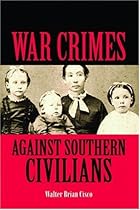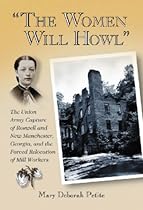Charleston – Shelled, Sacked and Exterminated:
Most often left out of the army of Abraham Lincoln’s accomplishments is the sack and destruction of American farms, towns and cities – and the fate of American women and children left in the path of Northern armies consumed with hate. The unrestrained plundering of Southern homes in New Bern, Fredericksburg and elsewhere in 1862 continued unabated through the destruction and occupation of Charleston in 1865.
Bernhard Thuersam, Chairman
North Carolina War Between the States Sesquicentennial Commission
www.ncwbts150.com
"The Official Website of the North Carolina WBTS Sesquicentennial"
 “The night of February 17-18 was one of horror and chaos, undoubtedly the worst ever experienced in the history of the city. There were more women in the city than usual, as those from the outlying plantations were sent in to get them out of the way of Sherman’s marauders.
“The night of February 17-18 was one of horror and chaos, undoubtedly the worst ever experienced in the history of the city. There were more women in the city than usual, as those from the outlying plantations were sent in to get them out of the way of Sherman’s marauders.
As darkness approached, conditions became worse. No one dared to go to bed. Fires were breaking out all over the city, and since the white firemen, who acted in a dual capacity of militiamen, were gone, only Negro companies were left to fight them. [A]n explosion was caused by the blowing up of the [ironclad] Palmetto State at her wharf. This was the gunboat that the women of the State had financed by selling their jewelry.
[It was rumored] that unoccupied houses would be taken over by the Union troops, at which news women and children rushed back and barricaded themselves in their homes. The soldiers of the 21st US Colored Troops, who were in possession of the city, started on a tour of liberation – anything that was not nailed down was taken. They went everywhere breaking into homes and helping themselves to whatever they wanted, cursing and raving at the inhabitants all the while.
On February 28, General Order Number Eight was issued calling on the citizens of Charleston to take the oath of allegiance to the United States [government] and providing that no passes or favors would be given to those who refused to take it. The order also stated that no guards would be placed over the houses of citizens for the protection of private property, but that any person fearing molestation should display the United States flag in a conspicuous position and that any person who plundered a house would be punished. Nothing was said about what would happen to a person who plundered a house not flying the United States flag.
Apparently the order was ignored, and plundering continued unrestrained, for General Gillmore wrote from Hilton Head to General Hatch in Charleston: “I hear on all sides very discouraging accounts of the state of affairs in Charleston; that no restraint is put upon the soldiers; that they pilfer and rob houses at pleasure, that large quantities of valuable furniture pictures, statuary, mirrors, etc., have mysteriously disappeared – no one knows whither or by what agency…”
A month later Gillmore issued another order instruction the officers stationed in Charleston to return the silver, pianos, organs, pictures and works of art they had stolen. It appeared that, with the officers looting and nothing being done about it, it was perfectly all right for the soldiers to help themselves. It is not recorded that any of the material was returned, for the simple reason that none of it was.
That a single piece of furniture or silver survived is a miracle. The silver could be buried, and most of it was…Some paintings were rolled up and hidden in attics; most of the others usually had a bayonet thrust through the throat as if it was a man, or through the heart if it was a woman. Holes were shot through the furniture. The silver was usually located by the method of putting a rope around the neck of the person who knew where it was and gently raising him off the ground, then easing him back so that his feet barely touched.
Col. W.W.H. Davis of the 104th Pennsylvania…wrote: “The plunder was not all obtained by the soldiers, but officers received a fair share. Some of them sent north pianos, elegant furniture, silverware, books, pictures, etc., to adorn their New England dwellings.”
Possibly William Howard Russell, the war correspondent for the London Times, best expressed the feelings of hatred that existed in the North when he wrote: “The war which was made to develop and maintain Union sentiment in the South…is now to be made a crusade against slave holders, and a war of subjugation – if need be, of extermination.” Charleston to all extents and purposes was exterminated.
(The Siege of Charleston, 1861-1865, E. Milby Burton, USC Press, 1970, pp. 320-325)
Bernhard Thuersam, Chairman
North Carolina War Between the States Sesquicentennial Commission
www.ncwbts150.com
"The Official Website of the North Carolina WBTS Sesquicentennial"
 “The night of February 17-18 was one of horror and chaos, undoubtedly the worst ever experienced in the history of the city. There were more women in the city than usual, as those from the outlying plantations were sent in to get them out of the way of Sherman’s marauders.
“The night of February 17-18 was one of horror and chaos, undoubtedly the worst ever experienced in the history of the city. There were more women in the city than usual, as those from the outlying plantations were sent in to get them out of the way of Sherman’s marauders. As darkness approached, conditions became worse. No one dared to go to bed. Fires were breaking out all over the city, and since the white firemen, who acted in a dual capacity of militiamen, were gone, only Negro companies were left to fight them. [A]n explosion was caused by the blowing up of the [ironclad] Palmetto State at her wharf. This was the gunboat that the women of the State had financed by selling their jewelry.
[It was rumored] that unoccupied houses would be taken over by the Union troops, at which news women and children rushed back and barricaded themselves in their homes. The soldiers of the 21st US Colored Troops, who were in possession of the city, started on a tour of liberation – anything that was not nailed down was taken. They went everywhere breaking into homes and helping themselves to whatever they wanted, cursing and raving at the inhabitants all the while.
On February 28, General Order Number Eight was issued calling on the citizens of Charleston to take the oath of allegiance to the United States [government] and providing that no passes or favors would be given to those who refused to take it. The order also stated that no guards would be placed over the houses of citizens for the protection of private property, but that any person fearing molestation should display the United States flag in a conspicuous position and that any person who plundered a house would be punished. Nothing was said about what would happen to a person who plundered a house not flying the United States flag.
Apparently the order was ignored, and plundering continued unrestrained, for General Gillmore wrote from Hilton Head to General Hatch in Charleston: “I hear on all sides very discouraging accounts of the state of affairs in Charleston; that no restraint is put upon the soldiers; that they pilfer and rob houses at pleasure, that large quantities of valuable furniture pictures, statuary, mirrors, etc., have mysteriously disappeared – no one knows whither or by what agency…”
A month later Gillmore issued another order instruction the officers stationed in Charleston to return the silver, pianos, organs, pictures and works of art they had stolen. It appeared that, with the officers looting and nothing being done about it, it was perfectly all right for the soldiers to help themselves. It is not recorded that any of the material was returned, for the simple reason that none of it was.
That a single piece of furniture or silver survived is a miracle. The silver could be buried, and most of it was…Some paintings were rolled up and hidden in attics; most of the others usually had a bayonet thrust through the throat as if it was a man, or through the heart if it was a woman. Holes were shot through the furniture. The silver was usually located by the method of putting a rope around the neck of the person who knew where it was and gently raising him off the ground, then easing him back so that his feet barely touched.
Col. W.W.H. Davis of the 104th Pennsylvania…wrote: “The plunder was not all obtained by the soldiers, but officers received a fair share. Some of them sent north pianos, elegant furniture, silverware, books, pictures, etc., to adorn their New England dwellings.”
Possibly William Howard Russell, the war correspondent for the London Times, best expressed the feelings of hatred that existed in the North when he wrote: “The war which was made to develop and maintain Union sentiment in the South…is now to be made a crusade against slave holders, and a war of subjugation – if need be, of extermination.” Charleston to all extents and purposes was exterminated.
(The Siege of Charleston, 1861-1865, E. Milby Burton, USC Press, 1970, pp. 320-325)




















